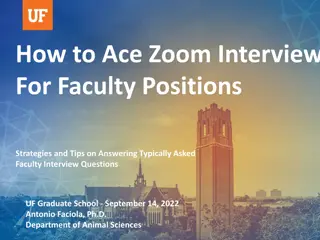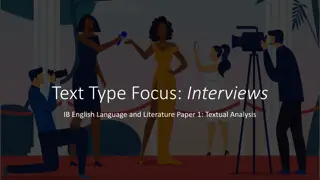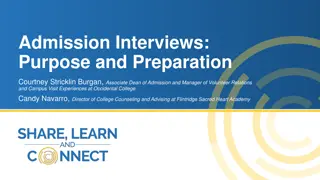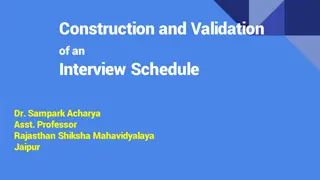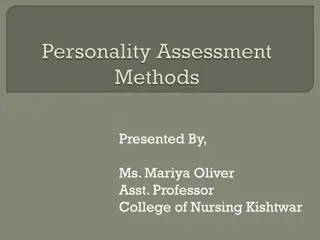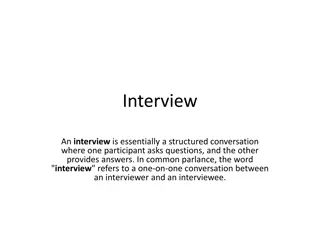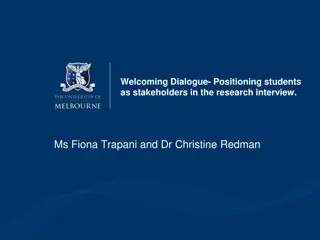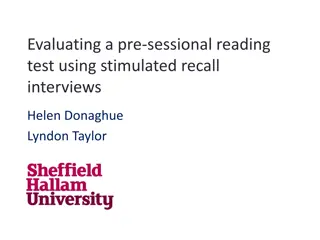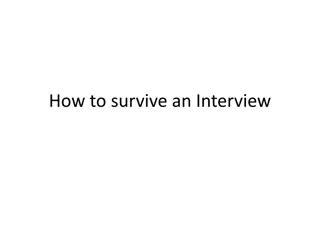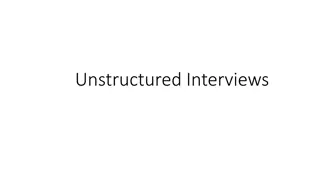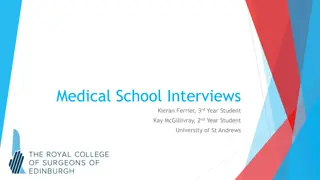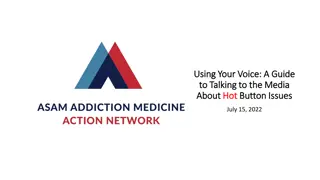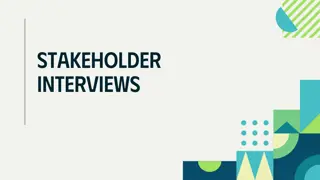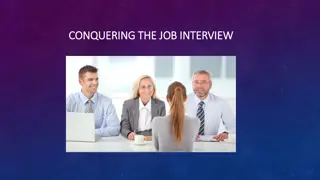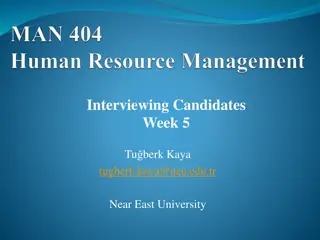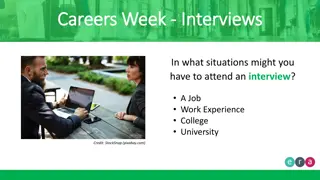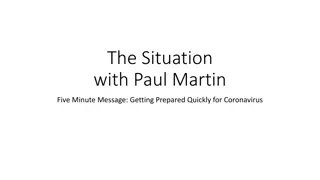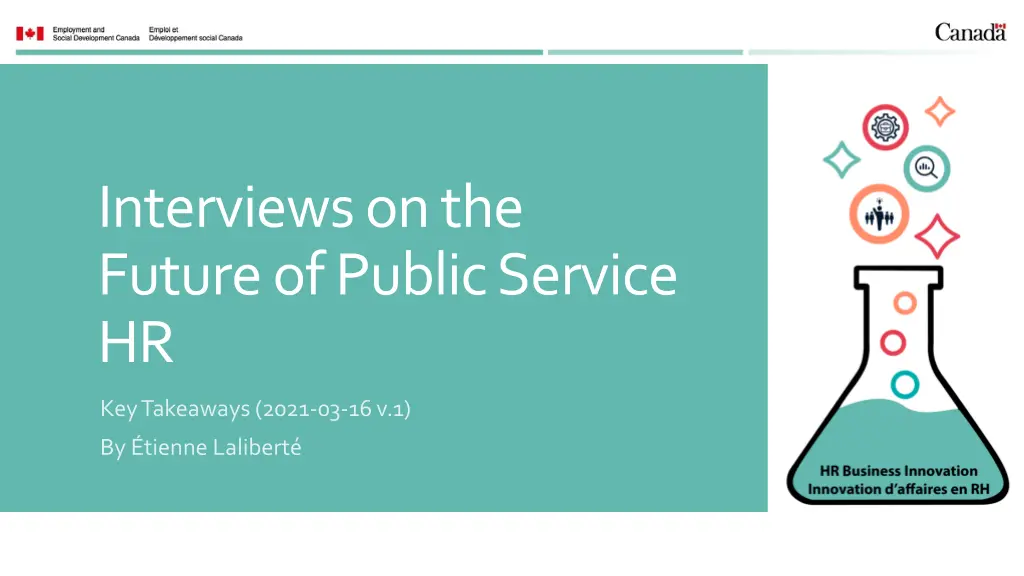
Insights from Interviews on Future of Public Service HR
Discover key takeaways from interviews conducted on the future of public service HR, exploring the impact of COVID-19 on HR roles and strategies for transformation. Insights from HR leaders help shape an aspirational vision for the future of the Department.
Download Presentation

Please find below an Image/Link to download the presentation.
The content on the website is provided AS IS for your information and personal use only. It may not be sold, licensed, or shared on other websites without obtaining consent from the author. If you encounter any issues during the download, it is possible that the publisher has removed the file from their server.
You are allowed to download the files provided on this website for personal or commercial use, subject to the condition that they are used lawfully. All files are the property of their respective owners.
The content on the website is provided AS IS for your information and personal use only. It may not be sold, licensed, or shared on other websites without obtaining consent from the author.
E N D
Presentation Transcript
Interviews on the Future of Public Service HR Key Takeaways(2021-03-16 v.1) By tienne Lalibert
In early 2020, the Assistant Deputy Minister (ADM) of the ESDC Human Resources Services Branch tasked the Human Resources Innovation (HRI) team with developing a 10-year aspirational vision for the Branch, with an emphasis on culture change. Then Covid-19 happened, disrupting public service HR in ways that would have been unimaginable only a few months earlier. The disruption also presented a unique opportunity to make fundamental changes and enhance the readiness of the HR function to meet future challenges. But what specifically? How? And where to start? The HRI team proposed to explore the ways the Covid-19 crisis might change HR's role in the public service and how the HR function must lead the transformation, by surfacing emergent strategies, ongoing initiatives, patterns, trends, and original ideas that might show the path forward. The approach the HRI team took consisted in interviewing a wide range of HR leaders across the public service: HR executives, subject matter experts and innovators. Using semi-structured interviews carried out virtually and a small set of questions as a starting point, we let the interviewees take the conversation where they wanted, following their expertise, interests, and main preoccupations. The findings alongside the products of strategic foresight will feed into the development of the aspirational vision for the Department. Background
550+ people invitedto participate: 37% scheduled an interview 8%declined or were unavailable 55% did not respond 15 of the 26 executives of the HRSB were interviewed 203 Interviews With215 People 8-week interview period (August 3rd September25th, 2020) 100+ hours of recorded content going into the analysis (approximately 700 pages of transcription, single-spaced!): 67.2% in English 28.4% in French 4.5% bilingual 3
from42 Organizations
In light of the challenges of the past year and the reset forced by the pandemic In terms of problems, gaps and limitations weneed to address, as wellas opportunities HR must seize Imagine the HR functionof the future In terms of mindsets and behavioursthat are holding us back and those wemust develop in HR In terms of fundamental changes wemust makeand next concrete steps wecouldtake In terms of questions wewouldliketo findanswers to
WhatWe Heard in the Interviews
Main Findings fromthe Interviews 7
Smaller, more immediate challenges and opportunities for which departments have a high level of autonomy and control: Work from home, telework, remote work and virtual work are (probably / hopefully) here to stay The technology and equipment necessary to fully enable and support work from home, telework, remote work and virtual work still require improvement and investment We have a great opportunity to grow the talent pool and access talent anywhere both the talent pool that could work in the federal public service, and the talent pool within the public federal public service (in terms of which jobs they may be able to do) 8
Bigger, more ambitious challenges and opportunities for which departments have a low level of autonomy and control: The archaic classification system was one of the most often mentioned fundamental changes HR must make to remain relevant An enterprise approach must be considered to address some challenges (e.g. data analytics capabilities, shared HR services, etc.) The HR community must take ownership of its destiny (e.g. need for strong horizontal leadership, professionalization of HR, etc.) The GoC must rethink the employment contract to meet the new reality (e.g. Terms and Conditions, collective agreements, etc.) 9
Bigger, more ambitious challenges and opportunities for which departments have a high level of autonomy and control: Data analytics and evidence-based decision-making: We must leverage HR data for their strategic interventions, and put the evidence at the center the decision-making process HR digitalization: We must make our HR products and services simple, modern and digitally enabled, available anytime, anywhere, from any device User-centricity: We must shift the focus of HR from compliance with policies and processes to meeting the needs of the users: managers, employees, candidates, etc. 10
Departments and agencies are already working on the more immediate challenges and opportunities they face, notably adapting to the new reality of working from home, telework, remote work and virtual work and should sustain the momentum Departments and agencies can influence bigger challenges and opportunities for which strong horizontal collaboration with other organizations and the leadership of the central agencies will be required Key Takeaways Departments and agencies are still in many regards catching up with the evolution of the HR industry outside the public service and several traditional mindsets, behaviours, tools and practices must make place for radically different ways of doing HR 11
Appendix1: Participants Profile The follow-up survey received 129 responses out of 215 interviewees (60% response rate)
Functional Communities, Roles
Region, Province or Territory
Appendix2: Interview Questions Submittedto the participants aheadof theirinterview
1. How well was the HR function of the public service prepared to handle Covid- 19? 2. What capability gaps, limitations or problems did Covid-19 highlighted in public service HR? 3. Beyond the short-term return to federal work sites (i.e. this fall) what are the fundamental changes that we need to make in public service HR to stay relevant in the next decade? 4. What opportunities are all of a sudden knocking at the door of public service HR, when they would have been either unimaginable or merely nice-to-have s only a few months ago? Which of these opportunities must public service HR seize? Interview Questions 5. What mindsets and behaviours are holding public service HR back? Which mindsets and behaviours must we develop in HR? 6. What s on your radar? What are the things that you think HR must start paying attention to right now otherwise the public service will no longer be competitive as an employer in 5 years from now? 7. What should be the next concrete steps we take to prepare the future of HR in the public service? 8. What questions relating to the future of HR in the public service are top-of-mind for you and that you wish your peers would have an answer to? 9. Before we conclude this interview, is there any question I might have missed that you wish I would have asked you?
Appendix3: SelectedQuotes From the Interviews on the Future of Public Service HR
Main Findings In a Quote What opportunities should public service HR seize? For me, this is the sudden big culture change - a culture change more specifically related to the changing universe from telecommuting, working from home, working remotely. [ ] The culture was not ready - half of the people at the management table said yes, the other half said no. But here we end up with a situation where we no longer have the choice to adapt to a new reality. [Translation] Work from home, telework, remote work and virtual work are (probably / hopefully) here to stay Smaller, more immediate challenges and opportunitiesfor whichESDC has a highlevelof autonomyand control One of the most obvious or painful shortcomings that Covid-19 identified early on in the public service was technology. People were not equipped. They were not equipped for a long time. [...] And even today, as an employer, we have not yet plunged. [...] But it is necessary to invest so that people are well equipped at home. [Translation] The technology and equipment necessary to fully enable and support work from home, telework, remote work and virtual work still require improvement and investment If you believe the purpose of HR is to get the right people in the right position at the right time, and if you have a more virtual work environment, that massively increases the pool of people you will have access to, because individuals who otherwise would say "I'm not willing to move" or "I have to be able to work from home . We used to tell them: "You can't do this job from home". [ ] Why do we need geographic limiters for any of the jobs? Why couldn't you equally be doing a management job or a policy job from Whitehorse as you could do from everywhere else? We have a great opportunity to grow the talent pool and access talent anywhere both the talent pool that could work in the federal public service, and the talent pool within the public federal public service (in terms of which jobs they may be able to do)
Main Findings In a Quote In order for the public sector to remain relevant, we're going to have to revisit our core assumptions on which we built 50 years ago. I mean: classification. Why are we still using boxes in a fluid world? Our world is increasingly fluid, it's increasingly fast-paced. And we have this anchor that we're dragging along, which says that "You know what, in this team, you cannot have this kind of skill set, because you don't have that box in your team . So those kinds of changes are critical in order to ensure our relevance as a public service organization that s nimble, that's ready to react to or act in advance of the change that's coming. But right now, how we're managing our talent remains associated a lot - unfortunately - with boxes, classification, bums in seats, as opposed to talent with talent management. The archaic classification system was one of the most often mentioned fundamental changes HR must make to remain relevant Bigger, more ambitious challenges and opportunitiesfor whichESDC has a lowlevelof autonomyand control This pandemic has created a backdrop where, as the federal government, we recognize that there are some limitations in the data we have at the enterprise level. And that perhaps, we really need to be very, very serious about that transition from the collection of 150 departments and organizations and agencies to an enterprise that is serving Canadians in Canada in a different way. And for me, a big part of that is data. [TBS- OCHRO] needs to start actually mapping some really important data sets. And those include job and work data and, and employee skills data. And this is really around employee identification and mobilization. That's really just the very first fundamental building block, actually enabling a massive overhaul transformation and change of our HR situation. An enterprise approach must be considered to address some challenges (e.g. data analytics capabilities, shared HR services, etc.)
Main Findings In a Quote The people management function for the government has to go through the same process than the financial management community went through (so CFOs) the same process the internal audit community went through (for internal auditors). There has to be a focused investment and attention on the "professionalization" of the people management function. I don't mean like certification or anything like that; I mean, instilling a sense of purpose, pride, and innovative lateral thinking and cohesion to the people management function for the entire government. That community needs to be recognized as a key functional community in the Government of Canada. I think that we should then use that established community to achieve some of the objectives we have, including shifting mindsets or behaviors for the organization or for the community as a whole [and] navigating the fine line between being business enablers, and also being guardians of our system. The HR community must take ownership of its destiny (e.g. need for strong horizontal leadership, professionalization of HR, etc.) Bigger, more ambitious challenges and opportunitiesfor whichESDC has a lowlevelof autonomyand control (cont d) Fundamentally, we have to look at our employment contract in the broadest sense. We have to think about what we're hiring people for and what we're going to tell them to expect. [ ] We have to move that yardstick in terms of the employee, and we have to prepare managers to be able to manage in this new world. So this, as we see isn't just a month worth of change. [...] So my biggest fear would be we don't want to go backwards at all, we want to at least hold our ground here and move forwards in terms of changing our employment contract with our people, in terms of how we manage the work, and the people. So these are huge, huge things. And like I say, it's almost too big. The GoC must rethink the employment contract to meet the new reality (e.g. Terms and Conditions, collective agreements, etc.)
Main Findings In a Quote For HR to stay relevant in the next decade, one of the fundamental changes we need to make pertains to data and actually being able to support the decision-making. Our role is supporting managers and supporting employees. And we don't have some of those basic enabling infrastructure pieces at where they need to be. Data analytics and evidence-based decision- making: We must leverage HR data for their strategic interventions, and put the evidence at the center the decision-making process Bigger, more ambitious challenges and opportunitiesfor whichESDC has a highlevelof autonomyand control We need to make sure there s continuous improvement on the digital side, and I would even say on the information management side because the way we organize our information, the way we manage our information, we are not as good as we should be. And because we re more digital now, it s even more important than before. [...] That s a concrete step that we should take collectively to make sure that as we become more digital and more virtual, that we can manage that information correctly. Get ready for a changing workforce! HR digitalization: We must make our HR products and services simple, modern and digitally enabled, available anytime, anywhere, from any device Talk to the clients, especially at the managerial or employee level, and understand their journeys and what their expectations are, and what they're experiencing, what they're feeling now, and what perhaps they would like to see. I think that is the most tangible, concrete step that the HR function or the branch could implement. But there seems to be a lot of resistance to it. If you implement sort of a client-centric or design-centric thinking, then you'd be much better prepared to implement new functions over the medium term, or be at least be open to them. The branch has to understand the stories that employees and managers are telling amongst ourselves to our colleagues about the HR function. User-centricity: We must shift the focus of HR from compliance with policies and processes to meeting the needs of the users managers, employees, candidates, etc.

